
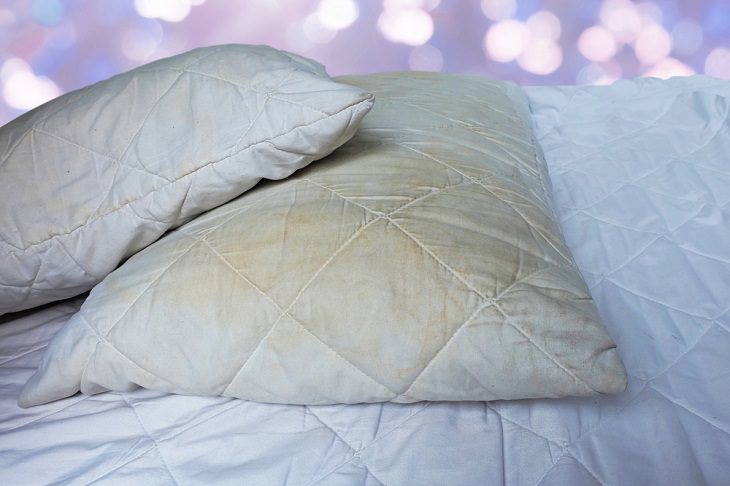
Experts say that, since pillows come in such close contact with our faces and tend to breed allergens, we should be washing them at least twice a year and even more if we live in a warm or humid climate.
Washing our pillows at least twice a year will ensure that any unpleasant smells caused by sweat and saliva would be washed away. Moreover, you might not be aware that dust from the air, dead skin cells, dust mites, oil from our hair and skin, and other allergens cling onto our pillows when they aren’t cleaned over a long period of time.

Before you go about washing your pillow, however, you must also test its viability. Is your pillow even worth washing? Or should it be replaced?
If there are visible lumps on your pillows, then it’s a good sign they need to be replaced. Similarly, if your pillow is too flat, then it is time to swap it out.
Also, while you may get rid of some of the existing bad odors after washing your pillows, some of them can be too stubborn. If you notice that the pillow still smells, even after a couple of washes, then it’s a good idea to get rid of it.
See Also: Don't Throw Away Your Old Pillows! Reuse Them Instead
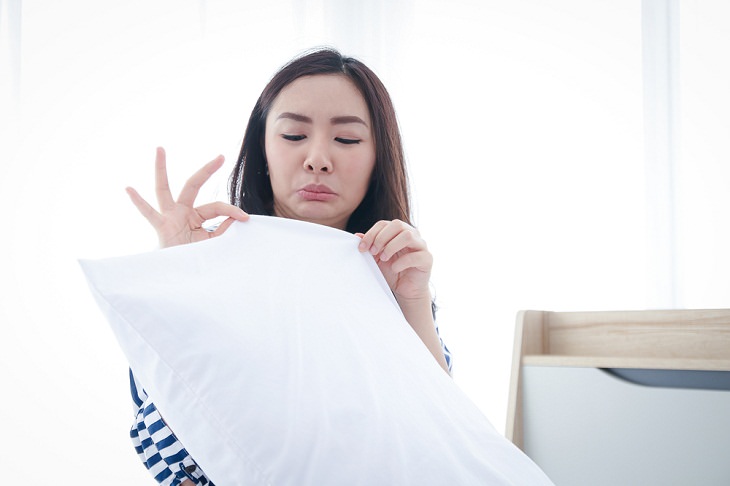
Now that you know that you have to wash your pillows at least twice a year, the next question is how exactly do we wash them? Should we simply dump them in the washing machine?
Here are some tips that will help you understand this better.


Found this post useful? Share it with others...

These Nifty Visual Guides Can Come in Handy For All of Us
Here are some really useful guides with some great life hacks and tips and tricks that can come in handy to anyone.

Home Hacks: 8 Smart Tips to Declutter Your Bedroom
Take note of these handy tips to achieve an organized and clutter-free bedroom.
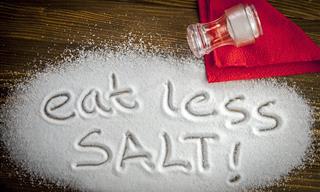
Looking To Cut Back On Sodium? Try These 5 Handy Tips
If you’re looking for ways to cut back on your sodium intake, these tips will help.

How to Clean Those Ugly Water Spots from Your Car
Ugly water spots on your car are a real nuisance. But if you know what to do, getting rid of them isn't too tough. Here are several effective tips.

Cleaning Guide: How to Get Rid of Any Fabric Stain
Staining your favorite piece of clothing can be quite frustrating. But with these tips, you can get rid of almost every type of garment stain.

Winter Weight Gain: Why It Happens and 5 Tips to Avoid It
Ever wondered why you tend to put on some extra pounds during the winter months? Find out why we gain winter weight and how we can avoid it.

The Musical Test That Could Detect Dementia Early
Researchers have developed a promising new approach: using music to detect the early signs of cognitive decline.

Ever Hear of the 54321 Shopping Method to Buying Groceries?
Grocery shopping has become increasingly stressful as prices continue to climb. Many shoppers find themselves struggling to balance their budgets while still putting nutritious food on the table. But a straightforward shopping strategy is helping peo
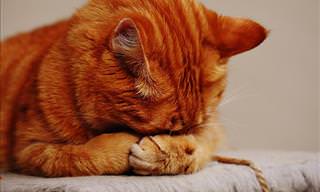
WARNING! This Common Ingredient Could Be Fatal to Cats!
They say that curiosity killed the cat, but new studies now show that certain essential oils may kill your cats too if you're not careful. Learn why here...

This Visual Guide Will Answer Many Wine Questions
This infograph will teach you all about the different wine styles, wine glasses, and wine tasting.
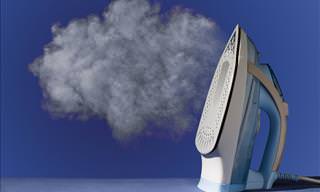 18:20
18:20
Your Day Is About to Get a Lot Easier with These Hacks
From making cooking easier to restoring household items, check out these incredible tips
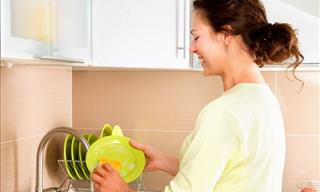
8 Everyday Activities That are Damaging Your Spine
Here's a list of everyday activities that harm your spine.
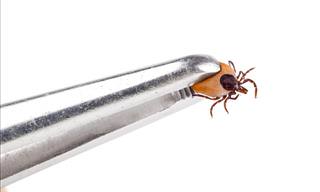
How to Properly Remove a Pesky Tick From Your Pet
Our beloved cats and dogs love playing outside just as much as we do and, just like us, they are susceptible to picking up the odd tick every now and again. Ticks carry a wide range of disease so you don't want one on your beloved pet. Here's how to
 2:15
2:15
How to Win at Every Tic Tac Toe Game...
Unlock the secrets to mastering Tic Tac Toe with our latest video guide.
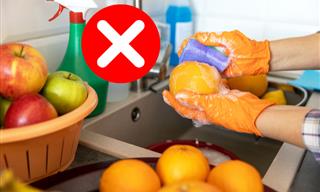
Washing Fruits and Veggies: Here's What You’re Doing Wrong
Don't make these mistakes the next time you wash your fruits and vegetables.

Suffering From Chronic Pain? These Tips Can Help Manage It
If you're suffering from pain, these mantras and mental tricks can help immensely in pain management and reducing the accompanying stress

Darken Graying Hair Using Potato Peels!
Do you spend a lot of time fighting gray hair? The following simple idea will allow you to darken hair graying quickly using something we all have: potato peels!
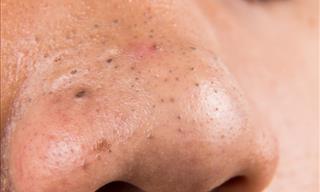
5 Natural DIY Remedies for Blackhead Removal
In this article, we'll teach you to get rid of blackheads using 5 easy and effective at-home methods
 28:22
28:22
Here’s Why Everyone Should Try 'No-Dig' Gardening
Grow plants year round with the no-dig gardening method.
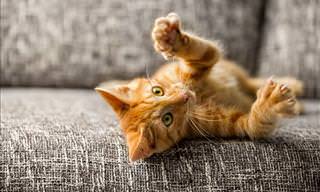
If You Own a Cat, Avoid These 8 Common Mistakes!
Most cat owners do their utmost to take care of their feline companions, but we all make mistakes. Here are 8 mistakes cat owners must stop making!
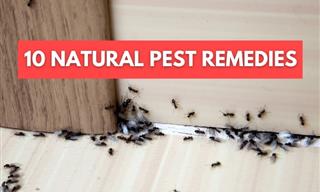
Natural Pest Control - 10 Ways to Get Rid of Various Pests
In this article, we list 10 natural remedies that will help you get rid of various pests, as well as several handy tips to control and prevent pest infestations.
 15:30
15:30
Live an Easier Life With These 24 Everyday Tips!
This video offers 24 different tips for everyday problems.

Practical Guide: 15 Useful and Effective Tips for Home DIY
The tips covered here span a wide range of projects you're likely to encounter—from painting and wallpapering to fixing squeaky floors and tackling basic plumbing issues.
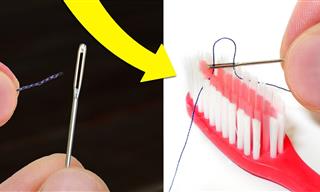 9:01
9:01
These Genius Old Life Hacks Have Passed the Test of Time
These age-old life hacks were once used by our grandparents. Turns out, they can still make our life easy.

11 Household Items You Should NEVER Throw Away
These ordinary household items may seem like they belong in the bin, but organizing experts advise to not throw them out, but repurpose them instead!

Learn 10 Simple Tricks For Regaining Control Of Your Body!
We've all experienced laughing when inappropriate, crying uncontrollably, and even annoying hiccups. With these 10 tricks, you'll be able to regain control!
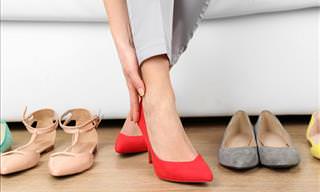
If You Wear These Shoes Often, You Are Damaging Your Feet
Wearing these shoes often can damage your feet!

Weeds Stand No Chance Against This Fantastic Weed Killer
How does a practically free, home-made, all-natural weed killer that's kind to the environment sound? Amazing, right? Here's how to make your very own.
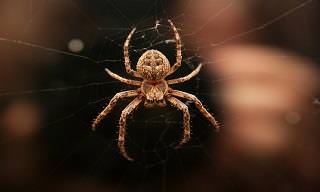
10 Natural Ways to Keep Your House a Spider-Free Zone
Having spiders in your home is never pleasant, nor are the chemicals normally used to get rid of them. Here are 10 natural ways of ridding your home of spiders.

Are You Guilty of These Everyday Posture Mistakes?
These mistakes are ruining your posture. Here’s how you can fix them!
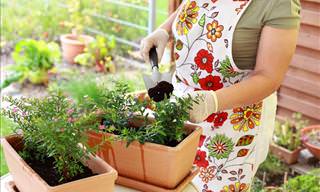
13 Great Tips That'll Ensure Your Container Pots Thrive
If you struggle to keep your container plants alive then you're definitely doing something wrong. Here are 13 great tips that you should heed!
 14:08
14:08
Can Animals Truly Predict Earthquakes?
Seismologist Lucy Jones debunks popular earthquake myths and tells how we can really prepare before a big earthquake hits...

You Must Read These Safety Tips Before Going For a Swim
A collection of safety tips for ocean and pool-goers.

How To Keep Your Glasses In Mint Condition For Years to Come...
7 simple tips that will help you keep your glasses in good condition for a very long time.

Your Old Spices Can Still Work Wonders Around the House
Here are 11 clever ways to use up spices that have lost their zing.
 1:03
1:03
Never Leave Water Bottles in Your Car.. Here's Why!
There are a lot of things that we know shouldn't be left in the car, but you probably never thought that this item could cause such harm!

How These People Beat Insomnia: 9 Enlightening Stories
9 excellent and proven methods for dealing with insomnia, which are recommended by people.
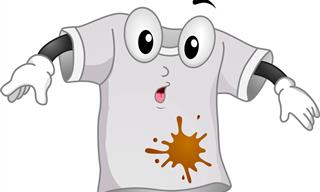
Have A Stain? Here's How to Remove It Quickly and Easily
We all have occasional "food accidents" that leave stains on our clothes, but you can remove the 18 most common food stains using the following simple methods.
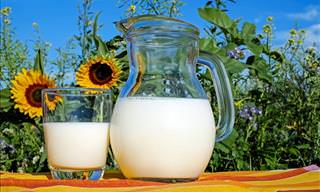
Learn How to Use Expired Milk with the Following 7 Tips
When we buy milk, we carefully check its expiration date. However, even if milk has expired, There are still many things it can be used for...
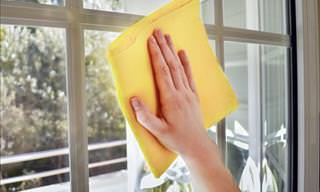
Make Cleaning Windows Less Tedious with This DIY Recipe
There is a quicker and more effective way to clean the windows in your house. Take a look at these two methods.

Fold Your Clothes the Right Way with This Guide
Have you been folding your clothes wrong all this time? These top 10 tips will help keep your clothes organized.

If You’re Taking Apple Cider Vinegar, You Must Know This
There is a right and wrong way to take apple cider vinegar, and doing so incorrectly may not just be ineffective, it could be harmful to your health.

Turn Any Pan Nonstick With This Easy Technique
With this easy hack, you can turn almost any pan into a nonstick surface—no special coatings required.

Get the Best Picture Possible On Your TV with These Tips
To get the best picture quality on your television, all you need is to make a few simple tweaks in the settings.
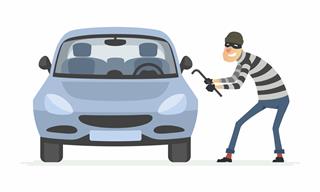
12 Things Car Thieves Don't Want You to Know...
Every 43 seconds, a car is being stolen in the United States, which is close to one million vehicles a year. These tips could prevent you becoming a victim.

Know the Signs: The Complete Guide to Body Language!
You can learn a lot about a person’s intent by reading his body language, so find out just what that wink meant with this helpful guide.

Wearing a Face Mask Irritates Your Skin? 10 Essential Tips
In this article, we’ve collected 10 essential tips that will soothe and protect your skin from mask-related irritation and breakouts...
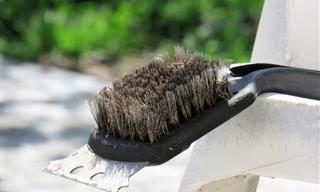
9 Surprising Uses for a Grill Brush Beyond the Grill
The grill brush isn’t just for cleaning your grill; it has many handy uses in your home.
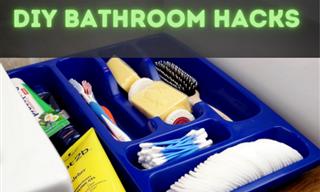
7 Handy Bathroom Hacks That Will Make Your Life Easier
Here are some handy bathroom life hacks that will help you keep it clean and well-organized conveniently.
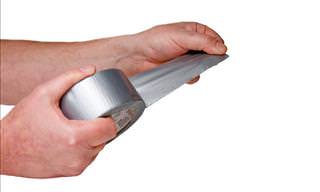 4:40
4:40
This Is What Makes Duct Tape So Strong! Impressive
This is why duct tape is so strong!
To enable your Ad-Free Subscription, please fill the fields below
Your subscription was successful, now you can enjoy an ad-free experience!! Note: To make sure you get no ads, please make sure to log in to your account. If you are logged in already, then refresh the page. The subscription can be cancelled at any time.


